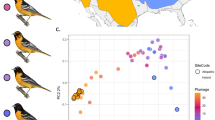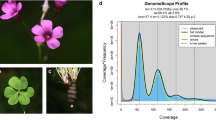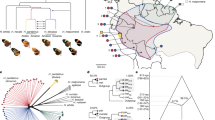Abstract
Genetic variation present in 599 individual Iris samples was examined at 50 presumptive loci (isozymes). The samples included allopatric populations of I. fulva, I. hexagona, I. brevicaulis and the putative hybrid species, I. nelsonii. In addition, we examined two populations from areas of overlap involving I. fulva with I. hexagona, and I. fulva with I. brevicaulis and I. hexagona. Allozyme data for both of these hybrid populations suggest the presence of genes from I. fulva, I. brevicaulis and I. hexagona. Bidirectional introgressive hybridization is indicated between I. fulva and I. hexagona. Individuals from a parapatric association between these two species possess various combinations of I. fulva and I. hexagona diagnostic markers. The pattern of genetic variation in this sample indicates the presence of advanced hybrid generations and localized introgression; this finding is in accord with a previous molecular genetic analysis (Arnold et al., 1990). Furthermore, currently allopatric populations of I. fulva and I. hexagona were found to have low frequencies of marker alleles diagnostic for the alternate species. These populations also contain a low frequency of alternate, diagnostic ribosomal DNA repeat length variants (Arnold et al., 1990). The allozyme (and molecular) data suggest that these allopatric samples represent previously introgressed populations. Findings from the allozyme survey indicate that I. nelsonii contains an array of markers characteristic for I. fulva, I. hexagona and I. brevicaulis. Furthermore, some of these markers are found in a present-day hybrid population involving I. fulva, I. hexagona and I. brevicaulis. These findings suggest that I. nelsonii is of hybrid origin, deriving from hybridization between I. fulva, I. hexagona and I. brevicaulis. The genetic analysis along with previous chromosomal, distributional and demographic studies of the Louisiana Iris species suggests that a number of mechanisms may have been involved in the stabilization of this hybrid derivative.
Similar content being viewed by others
Article PDF
References
Anderson, E. 1949. Introgressive Hybridization. John Wiley & Sons, Inc., New York.
Anderson, E, and Hubricht, L. 1938. Hybridization in Tradescantia. III. The evidence for introgressive hybridization. Amer J Bot. 25, 396–402.
Arnold, M L, Bennett, B D, and Zimmer, E A. 1990. Natural hybridization between Iris fulva and I. hexagona: pattern of ribosomal DNA variation. Evolution, (in press).
Arnold, M L, Contreras, N, and Shaw, D D. 1988. Biased gene conversion and asymmetrical introgression between subspecies. Chromosoma, 96, 368–371.
Arnold, M L, Shaw, D D, and Contreras, N. 1987. Ribosomal RNA-encoding DNA introgression across a narrow hybrid zone between two subspecies of grasshopper. Proc Natl Acad Sci USA, 84 3946–3950.
Baker, R J, Davis, S K, Bradley, R D, Hamilton, M J, and Van Den Bussche, R A. 1989. Ribosomal-DNA, mitochondrial-DNA, chromosomal, and allozymic studies on a contact zone in the pocket gopher, Geomys Evolution, 43, 63–75.
Bennett, B D. 1989. Habitat differentiation of Iris fulva Ker Gawler, Iris hexagona Walter, and their hybrids. Ph.D. Thesis, Louisiana State University.
Bennett, B D, and Grace, J B. 1990. Shade tolerance and its effect on the segregation of two species of Louisiana Iris and their hybrids. Amer J Bot, 77, 100–107.
Bert, T M, and Harrison, R G. 1988. Hybridization in western Atlantic stone crabs (Genus Menippe): evolutionary history and ecological context influence species interactions. Evolution, 42, 528–544.
Depamphilis, C W, and Wyatt, R. 1990. Electrophoretic confirmation of interspecific hybridization in Aesculus (Hippocastanaceae) and the genetic structure of a broad hybrid zone. Evolution, (in press).
Doyle, J J, and Doyle, J L. 1988. Natural hybridization in eastern North American Claytonia. Amer J Bot, 75, 1238–1246.
Gottlieb, L D. 1981. Electrophoretic evidence and plant populations. Progr Phytochem, 7, 1–46.
Grant, V. 1981. Plant Speciation. Columbia University Press, New York.
Hardin, J W. 1957a. Studies in the Hippocastanaceae, III. A hybrid swarm in the buckeyes. Rhodora, 59, 45–51.
Hardin, J W. 1957b. Studies in the Hippocastanaceae, IV. Hybridization in Aesculus. Rhodora, 59, 185–203.
Harrison, R G. 1986. Pattern and process in a narrow hybrid zone. Heredity, 56, 337–349.
Heiser, C B. 1949. Study in the evolution of the sunflower species Helianthus annuus and H. bolanderi. Univ. Calif. Publ. Bot., 23, 157–196.
Heiser, C B, Smith, D M, Clevenger, S B, and Martin, W C. 1969. The North American sunflowers (Helianthus). Mem Torrey Botan Club, 22, 1–218.
Huxley, J. 1938. Clines: an auxiliary taxonomic principle. Nature, 142, 219–220.
Marchant, A D, Arnold, M L, and Wilkinson, P. 1988. Gene flow across a chromosomal tension zone. I. Relicts of ancient hybridization. Heredity, 61, 321–328.
Mitton, J B, Linhart, Y B, Sturgeon, K B, and Hamrick, J L. 1979. Allozyme polymorphisms detected in mature needle tissue of ponderosa pine. J Heredity, 70, 86–89.
Moran, C, and Shaw, D D. 1977. Population cytogenetics of the genus Caledia (Orthoptera: Acridinae). III. Chromosomal polymorphism, racial parapatry and introgression. Chromosoma, 63, 181–204.
Nei, M. 1972. Genetic distance between populations. Amer Nat, 106, 283–292.
Potts, B M, and Reid, J B. 1988. Hybridization as a dispersal mechanism. Evolution, 42, 1245–1255.
Rand, D M, and Harrison, R G. 1989. Ecological genetics of a mosaic hybrid zone: mitochondrial, nuclear, and reproductive differentiation of crickets by soil type. Evolution, 43, 432–449.
Randolph, L F. 1966. Iris nelsonii, a new species of Louisiana iris of hybrid origin. Baileya, 14, 143–169.
Randolph, L F, Mitra, J, and Nelson, I S. 1961. Cytotaxonomic studies of Louisiana irises. Bot Gaz, 123, 126–133.
Randolph, L F, Nelson, I S, and Plaisted, R L. 1967. Negative evidence of introgression affecting the stability of Louisiana Iris species. Cornell Univ Agr Expt Stat Memoir, 398, 1–56.
Rieseberg, L H, Carter, R, and Zona, S. 1990. Molecular tests of the hypothesized hybrid origin of two diploid Helianthus species (Asteraceae). Evolution, (in press).
Rieseberg, L H, Soltis, D E, and Palmer, J D. 1988. A molecular reexamination of introgression between Helianthus annuus and H bolanderi (Compositae). Evolution, 42, 227–238.
Riley, H P. 1938. A character analysis of colonies of Irisfulva, Iris hexagona var. giganticaerulea and natural hybrids. Amer J Bot, 25, 727–738.
Shaw, D D, Moran, C, and Wilkinson, P. 1980. Chromo-somal reorganization, geographic differentiation and the mechanism of speciation in the genus Caledia. In Black-man, R. L., Hewitt, G. M. and Ashburner, M. (eds) Insect Cytogenet, Symp R Entomol Soc Lond, no. 10, pp. 171–194.
Soltis, D E, Haufler, C H, Darrow, D C, and Gastony, G J. 1983. Starch gel eletrophoresis of ferns: a compilation of grinding buffers, gel and electrode buffers, and staining schedules. Amer Fern J, 73, 9–27.
Soltis, P S. 1985. Studies of genetic variation in an intro-gressive complex in Clarkia (Onagraceae) PhD. Thesis, University of Kansas.
Viosca, P J R. 1935. The irises of southeastern Louisiana: a taxonomic and ecological interpretation. J Amer Iris Soc, 57, 3–56.
Author information
Authors and Affiliations
Rights and permissions
About this article
Cite this article
Arnold, M., Hamrick, J. & Bennett, B. Allozyme variation in Louisiana irises: a test for introgression and hybrid speciation. Heredity 65, 297–306 (1990). https://doi.org/10.1038/hdy.1990.99
Received:
Issue date:
DOI: https://doi.org/10.1038/hdy.1990.99
This article is cited by
-
Genomic collinearity and the genetic architecture of floral differences between the homoploid hybrid species Iris nelsonii and one of its progenitors, Iris hexagona
Heredity (2013)
-
Molecular evidence of hybridization in two native invasive species: Tithonia tubaeformis and T. rotundifolia (Asteraceae) in Mexico
Plant Systematics and Evolution (2012)
-
Inferring population structure and genetic diversity of broad range of wild diploid alfalfa (Medicago sativa L.) accessions using SSR markers
Theoretical and Applied Genetics (2010)
-
Distribution of parental DNA markers inEncelia virginensis (Asteraceae: Heliantheae), a diploid species of putative hybrid origin
Plant Systematics and Evolution (1997)
-
Mating system variation in hybridizing irises: Effects of phenology and floral densities on family outcrossing rates
Heredity (1994)



